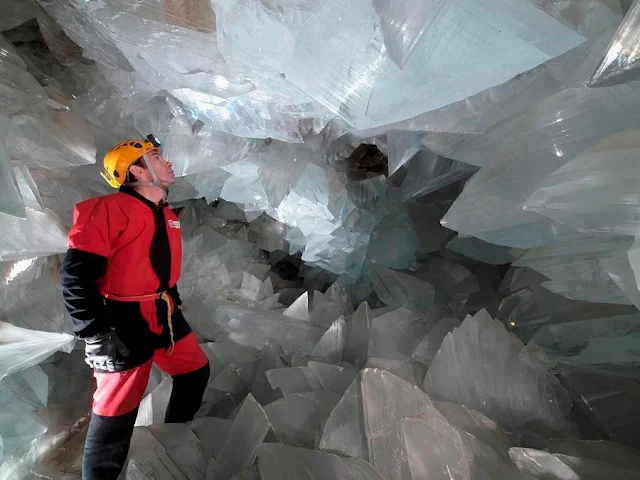Pulpí Geode: The World's Largest Crystal Cave
The Pulpí Geode is a giant, hollow rock formation filled with stunning gypsum crystals, some reaching up to 2 meters in length! It's one of the largest documented geodes in the world, boasting a volume of over 10 cubic meters and measuring roughly 8 meters long, 2 meters high, and 1.8 meters wide.
It occupies a space of 10.7 m³ (8 m long by 1.8 m wide by a 1.7 m average high) and is located at a depth of 50 m in the Pilar de Jaravía lead mine, in the Sierra del Aguilón, in the municipality of Pulpí, coinciding with the sea level, 3 km from the coast.
The geode, which is eight metres (26ft) long and crammed full of gypsum prisms, has been put under police guard to prevent souvenir hunters from raiding the extraordinary natural phenomenon.
The geologist who announced the find, Javier Garcia-Guinea, wants to turn the site into a tourist attraction.
 |
| Credit: Javier Trueba/MSF/Science Source |
How did the Pulpí Geode form?
The geode's genesis dates back approximately 6 million years, involving a multi-stage process:
Dissolution: Percolating rainwater dissolved the surrounding limestone, creating a cavity.
Hydrothermal activity: Volcanic activity heated groundwater, enriching it with dissolved minerals.
Crystallization: As the water temperature fluctuated within the cavity, selenite crystals began to precipitate and grow on the cavity walls, layer by layer.
Desiccation: Over time, the groundwater level receded, exposing the geode and its magnificent crystal formations.
 |
| Schematic sketch of the geode and its dimensions. Credit : A. Rivera |
Rumours of the existence of a giant gypsum geode had been circulating among mineral collectors since December.
But it was only on May that Javier Garcia-Guinea, from the Spanish Council for Scientific Research (CSIC) in Madrid, finally managed to track down the cave.
"The crystals are absolutely transparent and perfect," he said. The geologist has searched the international literature and can find no other object to compare in size.
The crystals of gypsum - hydrous calcium sulphate - are about half a metre in length.
The giant geode may have formed at the same time as a geological event called the Messinian salinity crisis.
 |
| Credit: Javier Trueba/MSF/Science Source |
At this time, about six million years ago, the Mediterranean Sea evaporated, depositing thick layers of salts. The same, salt-saturated fluids could have filled up the Spanish geode, which lies near the coast.
The drying out of the Mediterranean was probably caused by a restriction in the straits of Gibraltar, the sea's only connection with rest of the Earth's oceans.
 |
| Credit: Javier Trueba/MSF/Science Source |
Can I visit the Pulpí Geode?
Absolutely! Since 2019, the Geode of Pulpí has been open to the public for guided tours. These tours allow you to step into the geode and marvel at the glistening crystals up close. It's a truly unforgettable experience that will leave you awestruck by the power and beauty of nature.
 |
| Credit: Javier Trueba/MSF/Science Source |
 |
| Credit: Javier Trueba/MSF/Science Source |
See also:
The Rainbow Mountains in Peru very Amazing
Cave of Crystals "Giant Crystal Cave" at Naica, Mexico

%20(1).webp)






